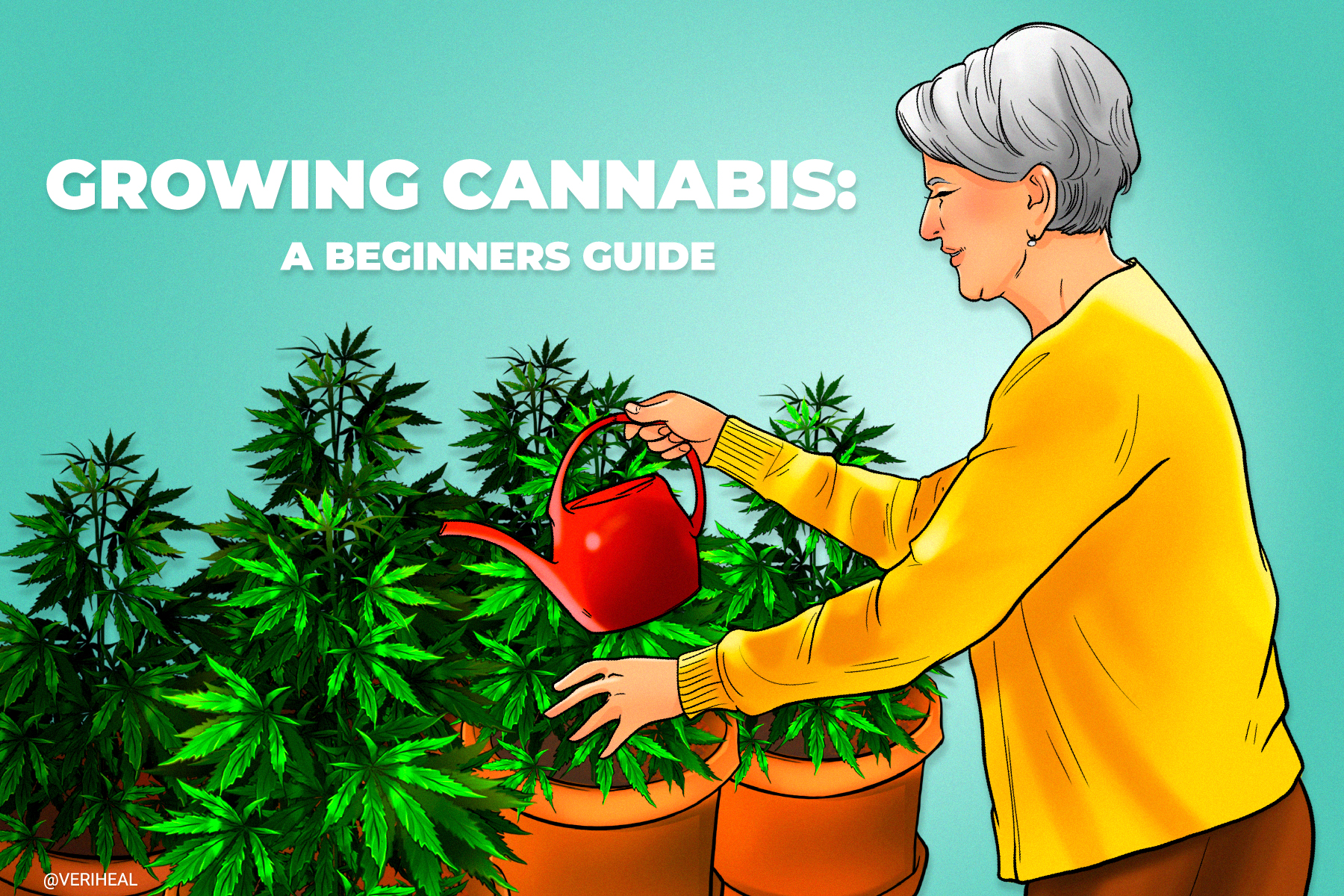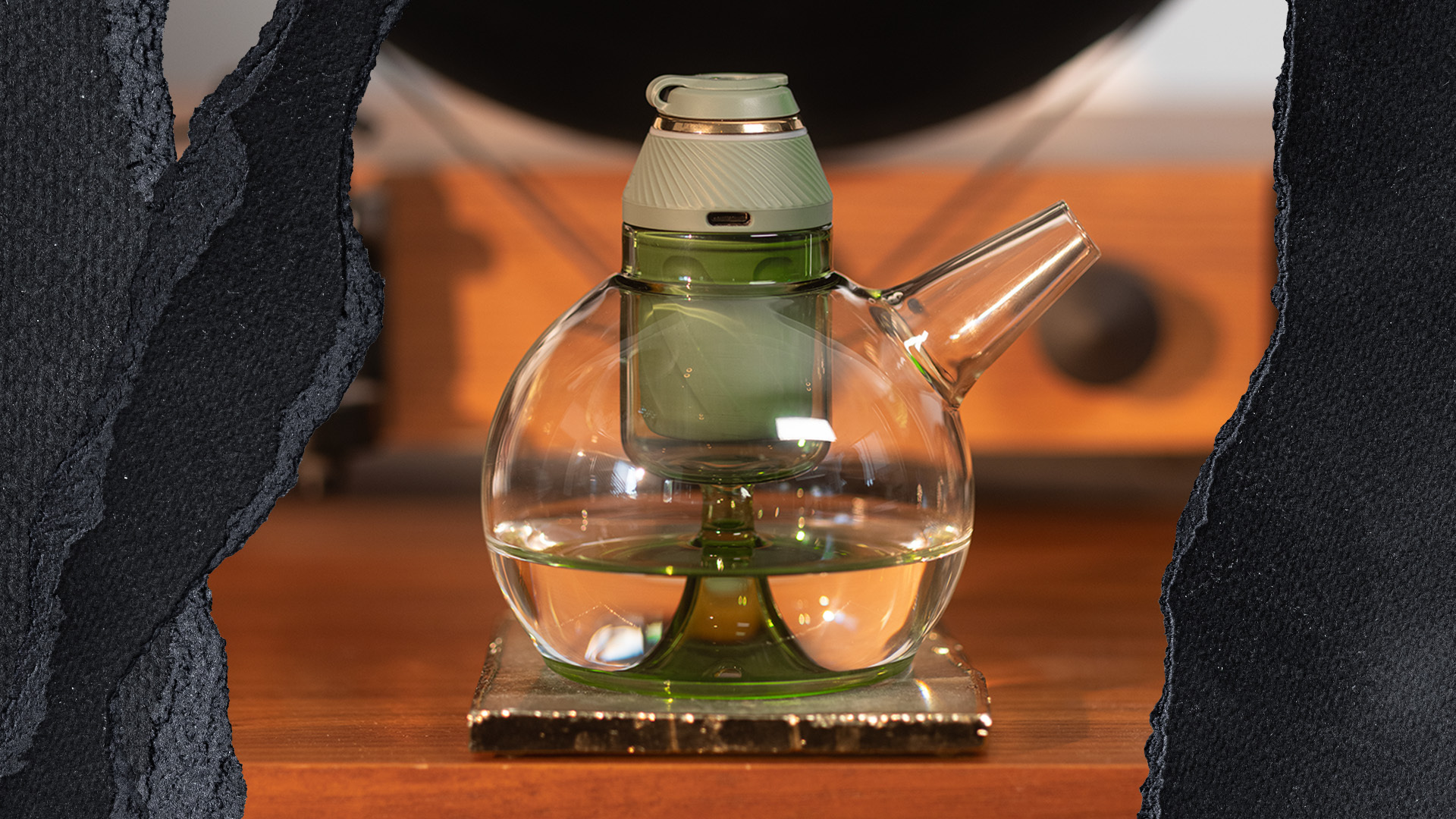As cannabis legalization is progressing around the world, many cannabis users are looking at whether or not growing their own plants at home is right for them. Before attempting home growing, it’s crucial to have the space, the right environment, and knowledge about cultivation. In this guide, we’ll walk you through the basics of growing your own cannabis indoors.
- Benefits to Growing Cannabis Indoors
- Common Growing Mistakes to Avoid
- Basic Supplies Needed to Set Up a Grow Operation
- Best Place to Grow Cannabis at Home
- Which Method to Choose: Soil Growing vs. Hydroponics
- Growing Variables to Consider
- Phases of Growing Cannabis
- Final Takeaway
Benefits to Growing Cannabis Indoors
There are many benefits to growing cannabis in general. Here are some of the top reasons why patients and consumers chose to grow their own cannabis even in markets where dispensary access is abundant.
Quality Control
One thing that many personal growers really enjoy about cultivating cannabis at home is their ability to know precisely what their medicine has been exposed to. Unfortunately, many large commercial grows require the use of pesticides, herbicides, and other chemicals. When you are growing your own cannabis, you get to choose how you control pests and what type of nutrients you feed your plants. For many people, this provides peace of mind that what they are consuming is safe and of the highest purity.
Growing Your Own Lets You Save
Aside from the cost of the initial setup to grow at home, in the long run growing cannabis at home will likely save you a lot of money. If you are someone who seldomly consumes, growing is probably not the most cost-effective. However, if you are a medical cannabis patient or a recreational consumer that utilizes a lot of cannabis regularly, growing at home could save you thousands of dollars each year.
You’ll Have More Choices
For many consumers and patients alike, there are specific strains of Indica or Sativa that we enjoy consistently or that always seem to provide relief. Unfortunately, sometimes finding that particular strain regularly is easier said than done. Growing at home can open up your options to specific strains, and there are seed banks and dispensaries across the country that provide genetics to home growers.
Growing Is Therapeutic
The love and care that cannabis plants desire is another reason why many people enjoy growing at home. It can be very therapeutic to nurture a plant throughout its lifespan. Growing is also a great way to connect with nature, and after all, it’s always fun to get your hands a little dirty!
Indoors Cultivation Offers Minimal Risks
There are some advantages to indoor growing in comparison to outdoor cultivation. In outdoor environments, it is much easier to maintain light and moisture as mother nature takes care of most of it. However, outdoors plants are susceptible to various pests and environmental risks—like spiders, aphids, and other creepy-crawly bugs—as well as animals that munch on cannabis leaves, like deer and rabbits. These risks can be prevented much easier in an indoor setting.
Common Growing Mistakes to Avoid
Before you get started on your first grow, let’s go over some of the most common growing mistakes to avoid.
Giving Your Growing Plants Too Much or Not Enough Nutrients
Giving your plants too many nutrients, sometimes referred to as overfeeding, can be a very easy mistake to make, especially since it may not be your fault. It has been found that most nutrient companies are recommending feeding schedules that are too high. Complying with the feeding schedules can overfeed your plant and cause more harm than good. More food does not mean more goods. Read more about common nutrient issues here.
Overwatering or Underwatering Your Plants
Over and underwatering are both common mistakes, although overwatering the plant happens more commonly. Both can be detrimental to your plant, but both are easy to fix. An overwatered cannabis plant will have leaves that are drooping but are firm to touch, whereas an underwatered cannabis plant will have leaves that are limp and brittle.
Incorrect Climate Conditions
Proper temperature and humidity are crucial to the growth and development of high-quality cannabis. The most common mistake people make is not being fully aware of the climate the plants are growing in. Temperatures that are too cold can stunt plant growth and can even kill the plants in more extreme cases. If the temperature is too hot, it will cause the plant to stress, which can lead to curling leaves, very bad buds, and it can also kill the plants in extreme cases.
The Wrong Lighting
Not having enough lighting for the plants is a common problem for indoor growers. When growing outdoors, common mistakes include positioning the plant with insufficient sunlight coverage, placing the plants too close to light sources, or exposing the plants to light for too long of periods, causing light burn.
Harvesting Your Grow at the Wrong Time
With regards to harvesting, common mistakes include doing so too early or too late. This can result in reduced effects from the cannabinoids of the plant and minimizing the medicinal and recreational effectiveness. Harvesting needs to be done at the right time to avoid losing potency as well as to avoid extreme cases such as rotting.
Basic Supplies Needed to Set Up a Grow Operation
Some of the things you will need to set up a grow operation at home include lights, grow containers, seeds or clones, a thermometer, a CO2 monitor, a humidity monitor, timers, nutrients, and most of all, patience.
- Lights: When it comes to choosing the best lights to grow weed indoors, it will all depend on your specific setup. For most home growers, LED grow lights are the preferred choice, because they offer the full spectrum of light needed for cultivation while utilizing less electricity. Other lighting options include MH (metal halide), HPS (high-pressure sodium), HID (high-intensity discharge), etc.
- Grow Containers: Grow containers are essential for marijuana growing at home as they will hold your grow medium and the plant throughout its various growth cycles. There are various types of grow containers including plastic, fabric, and even cement/stone varieties. The most commonly utilized however are plastic and fabric pots. Both of these come in a variety of sizes ranging from 1-20 gallon pots on average.
- Seeds or Clones: Cannabis seeds or clones are needed to get started. In many places where cannabis has been legalized, home growers are able to choose from a wide variety of seed and clone genetics at their local dispensaries or grow supply stores.
- Thermometers and Other Monitors: You must pay close attention to the temperature and humidity in your grow environment at all times. Additionally, ensuring that your marijuana plants are growing in a balanced pH environment with the optimal CO2 is crucial. Thermometers along with humidity, CO2, and pH monitors are all essential to monitor your plants’ environment. You may decide to use a humidifier or dehumidifier.
- Scissors: Scissors are essential for harvesting and trimming grown marijuana plants. Scissors are also useful during the growth process when completing defoliation (leaf removal).
- Timers: Timers, or lights that have timers, are essential because you, as the cultivator, are responsible for mimicking the light cycle that your plants grow under. This means that at different stages, your lights should automatically go off and on at certain intervals. Having a timer makes this easy so that you are not required to do it manually each day.
- Nutrients: When cultivating indoors, it is essential that you provide your plants with certain nutrients to help them grow better. Nutrient solutions can also be vital to the overall flavor, effects, and yield of your cannabis grow.
- Microscope: A microscope will be beneficial for various reasons including monitoring your plants for microscopic pests as well as determining whether your trichomes are at the optimal stage for harvesting your plants.
Best Place to Grow Cannabis at Home
Some of the most common places where people grow cannabis at home include a closet, spare room, bathroom, grow boxes, or tents. Let’s take a closer look at the advantages and disadvantages of each grow space.
Closet
While closets are convenient, they aren’t always the best grow room; it is difficult to tend to your plants in such a small space with access from only one side. It is also difficult to prevent light leaks as there are many ventilation issues that could lead to heat buildup, humidity issues, and light issues. If growing in a closet is your only option, though, go for it. It is advised, however, that this environment likely will not produce the best results.
An Extra Room
Turning an extra room in your home into a grow room can be a great idea, but it can also present some issues. Growing in the open within a large area can make controlling aspects such as your lighting, humidity, temperatures, and fresh air intake challenging.
Bathroom
Bathrooms are not ideal grow rooms. The amount of moisture in a bathroom is almost guaranteed to cause issues with mold and mildew. Not to mention that the excessive amount of moisture will also present a constant battle for you while trying to control humidity. Unless it is the only space you have, it is highly advised not to cultivate in a bathroom.
Grow Box
In recent years, grow tents have become one of the favorite growing areas for at-home cultivators. Grow boxes are a much more superior option for cultivating cannabis in comparison to growing it in a closet, an extra bedroom, or a bathroom. Grow boxes fully enclose the grow environment to help cultivators better maintain optimal conditions. However, they can be quite expensive and difficult to relocate.
Grow Tent
Grow tents are self-enclosed tents for cultivating cannabis. They are often prefabricated with areas to hang lighting, introduce airflow, and additional storage for monitors and other tools. Grow tents have become the go-to choice due to their ease of use, efficiency, and availability. Many grow tents offer a reflective interior to make the best use of your lighting. While rather expensive, they are one of the best choices, and many patients and consumers choose to make the investment.
Which Method to Choose: Soil Growing vs. Hydroponics
Let’s look at the benefits of the two different growing methods: soil growing vs hydroponics.
Soil
Soil is a popular growing medium for first-time growers, because it is cheap, easy-to-use, and is plenty forgiving. You can even buy pre-fertilized soil (our recommendation) so you won’t need to worry about adding any nutrients to your soil. If you are feeling adventurous, you can use regular soil and add nutrients as you go.
Hydroponics
Hydroponic systems are popular because they do not require soil. It is cleaner in that sense, and it can provide big yields if done right. Plus, plant growth is often faster when hydroponically grown.
There are a variety of grow materials to consider when using hydroponics:
- Clay pebbles
- Coco coir
- Vermiculite
- Rockwool
Each material can be found for a decent price, and there are often mixes of two or more of these materials that can be bought as soilless mixes that make getting started with hydroponic growing that much easier.
Growing Variables to Consider
Let’s discuss some of the most important variables to consider when cultivating cannabis at home and why controlling these variables is essential to the success of your grow.
Lighting
Cannabis grows with the cycle of the sun. This means that during the various stages of growth (which we’ll go over in the next section), the plant requires different amounts of light.
During the vegetative growth stage, your plants will crave light and should be exposed to light for a minimum of 16 hours each day, followed by 8 hours of darkness. When your plants are ready to enter the flowering stage, where they will begin to produce buds, you will need to mimic the changing of the seasons and reduce the light cycle to 12 hours of light and 12 consecutive hours of dark. Not controlling your lighting can cause detrimental harm to your plants, including stunted growth, hermaphrodites, mold, and powdery mildew.
Smell
For many years, trying to control the smell of cannabis was one of the hardest things cultivators had to do. Today, however, many individuals live where they are able to cultivate cannabis legally, and smell is not quite as big of a concern. If you live in an apartment, it is likely you will want to keep the smell of your grow under control as much as possible. The most highly recommended solution and the only sure way to eliminate all smells is to install a carbon filter in your growth tent’s ventilation or exhaust system.
Ventilation
Proper ventilation and air circulation within the grow area helps to strengthen your plants’ stems, resulting in stronger, healthier plants. Having a combination of the proper exhaust system as well as circulation will also help to control room temperature and humidity within your grow room. Ventilation and circulation are also vital factors for keeping mold and pests to a minimum.
When proper airflow moves across your marijuana plants, it helps reduce the moisture that is naturally created during the transpiration (water evaporation) process. Decreasing this moisture can help prevent powdery mildew, mold, and bud rot (a type of mold infection). Some growers use an exhaust fan.
Humidity
The wrong humidity levels in your grow environment can detrimentally affect the quality and yield of what you produce. When left unchecked, humidity levels can cause all sorts of issues, including bud rot, mold, mildew, and much more. By ensuring that you have proper ventilation and air circulation as well as humidity controls in place, you can help to mitigate concerns related to humidity.
Cannabis plants desire different humidity levels throughout the different phases of their growth. As a seedling or clone, humidity can be much higher (in the 65 to 80% range). As the seedlings or clones enter into the vegetative stage, they need less humidity, and growers look to provide 55 to 70% relative humidity. Once your beautiful ladies start to produce buds and enter into the flowering stage, however, that humidity level should be maintained between 40 and 50%.
Phases of Growing Cannabis
Let’s go over each of the stages of marijuana growth at a high level. For these references, we will be assuming that you are utilizing cannabis seeds rather than clones. If utilizing clones, the germination and seedling stages will not be applicable.
Phase 1: Germination
During this stage, marijuana seeds are exposed to hydration and begin to grow. It takes roughly 7 to 14 days for seeds to germinate.
Phase 2: Seedling
Once your seeds have popped and have been transplanted into their grow medium, they have entered the seedling stage and will continue to grow for a minimum of 2 weeks. The seedling stage is complete once you have determined which plants are females and males and have also removed the male plants from the crop and cultivation area. Starting with feminized seeds will produce female plants.
Phase 3: Vegetative
The vegetative stage is essentially the growth stage of your plants. On average, most cannabis growers will keep their plants in this stage for a minimum of 1 month. When purchasing clones, this stage could be much shorter. During this stage of growth, your plants should be exposed to light for a minimum of 16 consecutive hours a day.
Phase 4: Flowering
Once the vegetative stage is complete, and your flowering plants are ready to begin producing buds, it is time to change their light cycles, so they only receive 12 hours of solid light each day followed by 12 hours of complete darkness. During this stage, your plants will grow to their mature state. This stage of cultivation typically lasts one to three months.
Phase 5: Harvesting
Once your plants have grown to their full potential and their trichomes are showing that they are at the right stage under a microscope, it is time to harvest. Read more about the different stages of trichome development here. This is the final stage of cultivation when you must say goodbye to growing your plants and cut them down. The plants are chopped down, dried, trimmed, and cured.
Harvest time requires the most patience to achieve proper curing. One of the easiest ways to see if you have reached the proper cure is to simply try to smoke some of the flower in a bowl or joint. If it will not light or stay lit and still has a very plant-like flavor (think vine ripe tomatoes), it likely hasn’t reached its peak. Other than testing, you must trust your sense of smell and feel to determine if the flower has cured to its fullest potential.
Final Takeaway
As you can see, there is a lot to consider when setting out to cultivate cannabis at home. The great thing, however, is that no matter what space you have, what level of knowledge you possess, or how little money you wish to spend, there is a way to cultivate healthy plants at home as long as you have the dedication to doing so. Today, there are hundreds of books available that can assist with every aspect of cannabis cultivation, as well as many groups and communities across social media dedicated to helping at-home growers cultivate the best cannabis possible!
So what are you waiting for? Get out there and start growing today, and be sure to let us know what questions you may still have regarding growing cannabis at home in the comments below!
Author, Share & Comments















